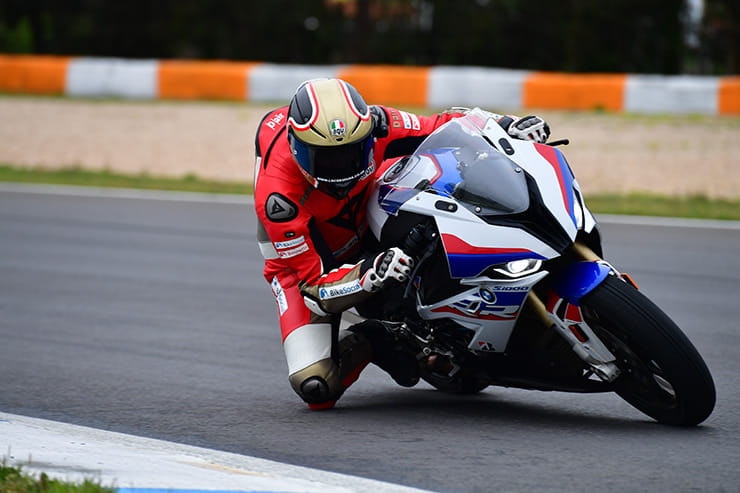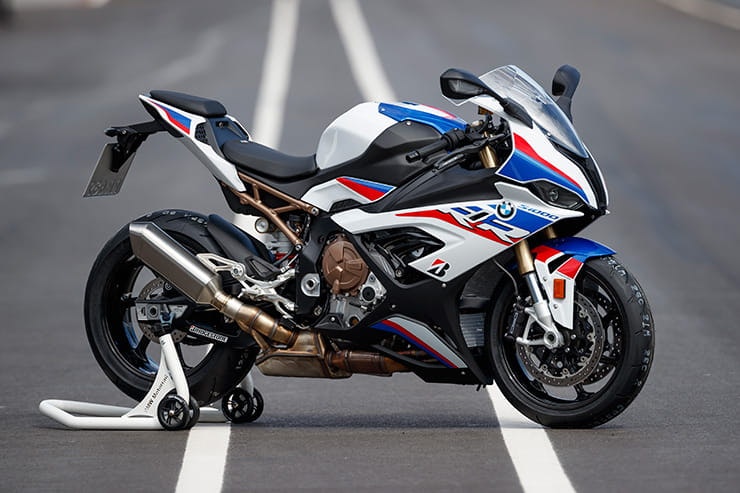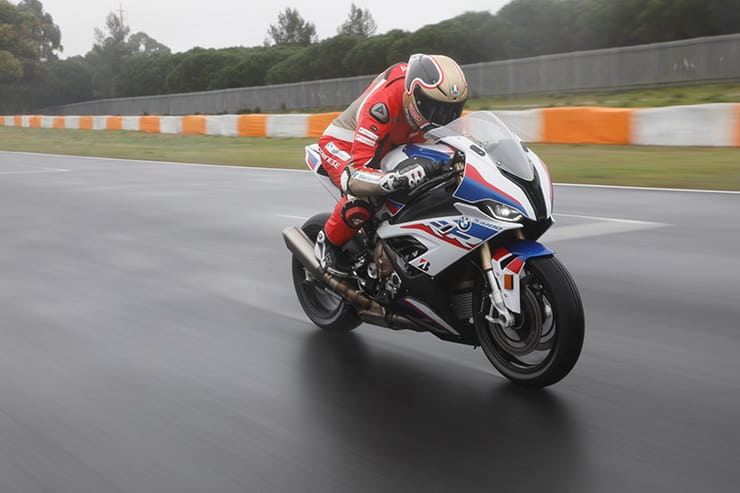BMW S 1000 RR (2019) - Review
By Michael Mann
BikeSocial Managing Editor
08.03.2019
KIT CREDITS
One-piece Leathers
Dainese D-air Racing Mugello, £2,799.95 | www.dainese.com
(Custom fit and personalised via Dainese Custom Works)
Boots
Dainese R Axial Pro In, £339.95 | www.dainese.com
Gloves
Dainese Full Metal 6, £299.95| www.dainese.com
When your predecessor is the officially the fastest ever machine to have lapped the Isle of Man TT Mountain Course, you’ve got some seriously big shoes to fill. Of course, you could argue that if it ain’t broke then why fix it… but where’s the challenge in that? Four years ago when the project began to make BMW’s headline sports bike even better than before, the new model brief was to be one second faster on the track (short circuit), more than 10kg lighter and easier to control. But with Ducati, Aprilia, Kawasaki, Suzuki, Honda and Yamaha all impressing with their track-focussed weapons in recent years, have BMW tooled-up and struck gold with the 2019 S1000RR?
10 years since the original game-changing S1000RR impressed so mightily in its debut year, the 2019 model, marking the 3rd new generation in the family, has come on leaps and bounds including the riddance of those asymmetrical headlights – not everyone’s cup of tea. Not only does the overall look get upgraded while still retaining the recognisable silhouette, but immense improvements to the engine, frame, suspension, electronics and rider control systems warrant the “new from the ground up” comment from the German marque.
Over the past decade, this superbike entrant in the constant and fierce field of finding headline bhp levels has always been one of the most user friendly with its size and suite of rider aids, not to mention significant dynamic ability and arm-wrenching power. So, what about the new model – on paper the transformation matches that of Susan Boyle’s prospects between standing on that stage to opening her mouth, so to find out if BMW have made the best even better, off I went to Estoril in Portugal for the International Press Launch… although those in charge of weather had better ideas.
Above: two colour options
2019 BMW S1000RR Price
Depending on the model selected, there are only two individual colour schemes; Racing Red or the traditional Motorsport (Racing Blue, Lightwhite, Racing Red) which can be found on the M Package machine. Surely there’s scope for more colour options in the future but for now, that’s your lot.
S1000RR: £15,290
S1000RR Sport: £16,700
S1000RR M Package: £19,315
The bikes are not expected in dealerships until June 2019 but in the meantime, here are the prices including example PCP deals for each model:
2019 BMW S 1000 RR press launch
At the press launch, Michael Mann speaks to Josef Machler, Project Manager of the S1000RR range since day one, about entire product range and new electronics
Power and torque
Peak power in good old bhp translates from 152 kW to 203.8bhp and is achieved at a red-line approaching 13,500rpm and that shows an increase of 8 bhp (6 kW) from the 2018 bike. There’s slightly more power in the middle of the rev range between 5,000 – 8,000 rpm and again the top end from 12,500rpm.
However, while peak torque figures of 83.3 lb-ft (113 Nm) @ 10,500rpm isn’t much different to before, it’s the massive change in the mid and top-end that translates to epicness out of a corner or swinging around the country roads. And that’s somewhat down to the ShiftCam technology we were introduced to several months ago via the boxer-engined R1250GS, and now the variable valve timing cunning has been translated for the in-line four motor.
From 4,500 – 8,000rpm the huge leap in engine torque is evident not only via the graph but by the powerful drive the 999cc engine offers, out of a slower corner for example. More than 73.8 lb-ft (100 Nm) of torque is available right through the useable 5,500rpm – 14,500rpm and represents a significant increase from before. The internal fight between engine performance and traction control was one that, for my safety and sanity, thankfully the latter was in control of. It didn’t stop the orange disco light on the dashboard submissively flickering for 9/10ths of the damp Estoril lap!
Coming around the long final corner onto the main straight at the 2.6-mile Circuito do Estoril my exit speed was slightly compromised given the conditions and Bridgestone Racing Battlax W01R (wet weather) tyres but snicking into 6th gear across the start/finish line and the top speed I saw was an indicated 268kph (166.5mph) although I did see footage of a test rider record 285kph (177 mph) the previous day, which was dry.
Engine, gearbox and exhaust
Unsurprisingly, faster and lighter were two of the key objectives when the development of the 2019 double R began and to be able to shave 4kg from the engine weight alone makes a significant step in the right direction to achieve both. As we’ve already asserted, the ‘ShiftCam’ variable valve timing has demonstrated advanced mechanics and boosted performance while reducing fuel consumption and emissions too. Add the world’s first ever hollow-bored titanium intake valves and speed resistant rocker arms into the equation and the internal combustion engine suddenly takes on a whole new performance level.
The in-line four is narrow and while a V4 arrangement was considered, the engineers remained with tradition which was integrated into a new and lighter ‘Flex Frame’, acting as a load-bearer. They also somehow designed an engine with a seemingly incompatible higher peak output with increased torque in the low-mid rpm range, all while saving 4kg. Not that the outgoing model was slow but this is one hell of an evolution to make the bike stronger, faster and more controllable. You know that when enticing the throttle back the engine is just begging to be let loose, yet it strains at the leash in a dignified manner instead of leaping about like a rabid dog, wanting to instantly wreck tyres and pull arms out of sockets.
The throttle connection is sublime, even better than previous RR’s in fact, giving an instant engine reaction to the slightest input while the crisp gearbox changes with the standard fit quickshifter (both up and down) was the source of zero miss-shifts, false neutrals or any other drama. Sweet little blips with minimal resistance on the way up, then about 1% more effort is required on the way back down – evident when hard on the brakes into T1 at the end of a 165mph+ straight. Down four gears in as little time as it takes to say this sentence. The gear shift can be inverted into a race-style pattern if required, while a launch control system and pit lane limiter are also available with the ‘Pro Modes’ option.
The completely new exhaust system may well save a further 1.3kg but you’ve got to feel sorry for bike manufacturers with obligations to conform to Euro 4, or in this case with the S1000RR, Euro 5 regulations because the actual power they know they can make from the motor becomes so restricted with guidelines that mess with engine breathing and cumbersome exhaust runs. The BMW version is not the prettiest and I feel sorry for them. The back-pattingly brilliant engine, frame, electronics and suspension development are unfortunately paired with a collector box looking like the love-child of C3PO and a cheese grater.
Ignore the eye-sore and just concentrate on the achingly good engine and chassis blend; it’s as compatible as fish and chips (or should that be sauerkraut and frankfurter?) offering instant confidence with weight loss and performance to rival any lithe, athletic road-legal sports machine.
Above: new Flexframe and swinging arm
Handling, suspension, chassis and weight
As if the rest of the bike wasn’t impressive enough, the diet-friendly saving of 14.5kg (with the M Package) over the 2018 bike makes it the lightest machine in the class. And it makes a world of difference when getting the bike turned, aimed at the apex – even while trail braking - holding the line and rewarding the permission request to feed in the power. It feels sufficiently balanced with its refined suspension geometry allowing me to concentrate on feeling the level of grip and knowing when to pick the throttle up.
On the M Package are the carbon wheels which are a big contributor to that weight loss but are also significant when flicking the bikes from one side to the other with such ease, making mincemeat of the transitions. OE tyres on the standard bike will be Bridgestone S21 while on the Sport and M Package bikes it’ll either come on Michelin Power RS or Metzeler Race Tec RR. Although while the Estoril circuit surface remained damp, our test bikes were fitted with the oh-so-confidence inspiring Bridgestone Racing Battlax W01R’s. There wasn’t any rain but the standing water glistened on the recently resurfaced asphalt. Yet after only a handful of laps the bike’s new components and tyre combo worked wonders producing lean angles of 41 degrees each side. Even though the electronics had been set to ‘maximum safety blanket’ mode, the BMW is still more than equipped to thrill.
On first impressions I felt the riding position to be more comfortable than most sportsbikes, noticeable because my wrists didn’t feel like they had all the weight on which in turn allowed my shoulders to relax a little. It’ll be interesting to see how it translates into a road bike. The M’s sporty seat is roomy enough to get all 6ft of me as tucked in as possible down the main straight, pushing against the rear of the seat unit and getting plenty of protection from the screen.
Dynamic Damping Control is further developed and is part of the new Marzocchi semi-active suspension set-up which is well matched to the new Flexframe, offering a silky ride, more feedback and such stability. Fine, I understand this was only a circuit-based launch and the real test is when I face the B660 and its ripples but when attacking the track, there’s some top quality good working wonders to keep the dynamics of the riding experience to a very high level.
Above: Front calipers are now by Hayes, M Performance seat and carbon wheel close-up
2019 BMW S1000RR Brakes
Phenomenal. Simple as that. Once there’s a little heat into those 320mm twin discs complete with new-fangled Hayes calipers, the stopping power becomes cultured and refined, stopping the mighty beast with decorum and allowing you to glide into corners with precision and stability. The adjustable lever gives superb feedback allowing you to trust an extra smidgeon of squeeze if required. Underneath, the bike’s 6-axis sensor brain is doing all the clever work to keep the suspension from diving, the rear wheel from lifting and the tyres from losing any grip. It’s a remarkable system.
The updated system not only shaves 0.5kg in weight from the previous model but also includes ABS Pro which increases braking prowess when leaning.
Above: Controls on the left but even though this example is in German you can still see the explanation the screen offers for each setting
Rider aids and extra equipment / accessories
The new 6.5” instrument panel is new-age stuff and is far more modern than the buttons, switches and dials used to operate it. Clear, easy to read and with several options of what and how the information is displayed, that is the tip of the iceberg in terms of what can be achieved via it. Even though the Product Manager said, “You don’t need a manual because it’s so user friendly”, it still took 10 minutes to talk through the vast array of options.
From suspension set-up, traction control levels and wheelie control to throttle response, engine braking and riding modes (Rain, Road, Dynamic and Race as standard plus Race Pro modes 1, 2 and 3 in the Pro Modes option), there are hundreds of settings to completely customise the ride best suited to you and the scenario. Though it might take some time to fine tune them. I’m now beginning to understand the complexity of equipment used by top level racers and almost accepting their justification of “not being able to find the right setting” when they’re 0.1s per lap off their team-mate.
As with the latter bikes in the S1000RR history, several upgrade packages are on offer:
M Package: Pro Mode, Motorsport paint finish, M carbon fibre wheels, M light weight battery, M sport seat, M chassis kit with rear ride height adjustment and swinging arm pivot.
Dynamic Package: Next generation Dynamic Damping Control DDC, heated grips, cruise control.
Race Package: Pro Mode, M forged wheel, M light weight battery, M chassis kit with rear ride height adjustment and swinging arm pivot.
BMW also offers an extensive range of accessories and optional equipment for a bit of customisation from an alarm, tinted windscreen, passenger seat cover and over 30 parts from the M Performance range to tyre pressure control, heated grips, Pro Modes and luggage.
Rivals
If there’s £20k-or-so burning a hole in your pocket for a crème-de-la-crème road-legal sportsbike then you’ve got one hell of a choice; the new BMW comes in at a fraction under the price of a Ducati Panigale V4 while the top entrants from Yamaha, Kawasaki and the forthcoming Aprilia are the north-side of £20k. Suzuki’s GSX-R1000R didn’t make it onto this competitor table mainly because of price, which in some minds might not be a sensible move, Honda’s Fireblade SP could and should be here as a proper daily use machine but we only have a finite amount of space:
Above: gone are the asymmetrical lights – hurray!
2019 BMW S1000RR verdict
Pulling into the pits after a highly-sophisticated yet sense-barraging track session and allowing your eyes to find their way back into their sockets, because even with the sublime and predictable nature of the chassis and swathes of electronical goodness they still allow for a degree of lunacy without getting too out of control. BMW have built a machine that offers the most rewarding ride; it has the capability to bend your mind while at the same time wrapping you in a coat of safety where seemingly nothing bad can happen.
It’s just a shame the Portuguese weather didn’t play ball, giving us just one 80% dry session – albeit still on the full wet tyres. However, the good news is that I’ll be riding a 2019 S1000RR for the large part of the coming year so will be able to assess the pros and cons with as many scenarios as I can get myself into.
The S1000RR has the ability to outperform 99.9% of the world’s riders so the challenge now is finding the right set-up to help maximise your ability and make you feel as super-heroic as I did. And it’ll undoubtedly be heading to a BSB, WSBK and TT podium near you soon.
Right, I really have to have a lie down now.
Three things I loved about the 2019 BMW S1000RR …
First-class and user-friendly electronics
Customisation of rider settings
Outrageous ability as a road or track machine
Three things that I didn’t…
When do many options become too many options, electronically speaking?
Only available in two colours
Plethora of buttons and switches across the handlebars are neither neat nor modern
2019 BMW S1000RR spec
To learn more about what the spec sheet means, click here for our glossary
After something even more exclusive? Meet BMW’s first ‘M’ bike – the BMW M1000RR – a 209bhp, 192kg street-legal WSB machine!


